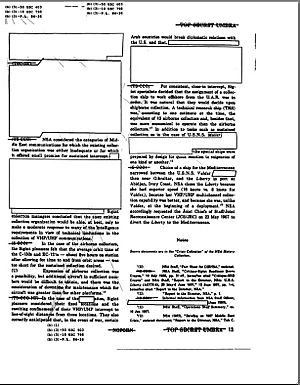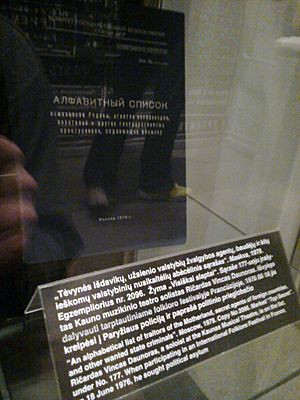Classified information facts for kids

Classified information is special information that a government or organization wants to keep secret. It's like having a secret code or a hidden message that only certain people are allowed to see. This information is protected by rules and laws. If someone shares it without permission, there can be serious consequences.
To handle classified information, people often need a special permission called a security clearance. Getting this clearance usually means they have to pass a background check to make sure they can be trusted. Even some companies and groups that aren't governments also keep their important information secret, like special business ideas or inventions.
Over time, some secret information becomes less sensitive. When this happens, it can be "declassified," meaning it's no longer secret and can be shared with everyone. Many countries now have laws that let people ask to see government information, which is called "freedom of information."
Contents
Why Governments Keep Secrets
Governments classify information to keep it safe. The most secret information is protected because it could put a country's safety at risk if it got out. Classifying information helps governments decide what counts as a "state secret" and how much protection each secret needs. This depends on how much harm the information could cause if it fell into the wrong hands.
Sometimes, officials might share secret information with reporters on purpose. They might do this to get a message out to the public or for political reasons. For example, some U.S. presidents have shared sensitive details to explain their ideas to the public.
Levels of Secrecy
Different countries have their own ways of classifying information, but most use similar levels. Here are some common levels, from the most secret to the least:
Top Secret (TS)
Top Secret is the highest level of secrecy. Information at this level is so important that if it became public, it could cause "exceptionally grave damage" to a country's safety. Sometimes, Top Secret information is even more divided into smaller, super-secret parts. You might need a special code word to access these parts.
Secret
Secret information is also very important. If this material became public, it could cause "serious damage" to a country's safety.
Confidential
Confidential material could cause damage or problems for a country's safety if it were shared publicly.
Restricted
Restricted material might cause "undesirable effects" if it became public. This means it could cause some problems, but not as serious as the higher levels.
Unclassified
Unclassified isn't really a secret level. It's for government documents that don't need any special protection. This information is considered low-impact, so it's okay for anyone to see. Sometimes, information that was once secret becomes unclassified after a long time.
Clearance and "Need to Know"
Having a security clearance means you're allowed to see certain levels of classified information. But it's not just about having the right clearance. You also need a "need to know" the information. This means you must have a good reason related to your job or duties to see that specific secret. So, even if you have a high clearance, you can't just look at any secret document you want.
Sharing Secrets Between Countries
When one government agency shares secret information with another country's government, they usually have a special agreement. This agreement explains how both sides will protect the information.
Protected Information
Not all sensitive information is about national security. "Protected information" is a type of sensitive information that doesn't relate to a country's safety but still needs to be kept private. This is because sharing it could harm people or private interests.
- Protected C (Extremely Sensitive): This is for super sensitive information. If it got out, it could cause very serious harm to people, even if it's not about national security. An example might be the identities of people helping with investigations.
- Protected B (Particularly Sensitive): This protects information that could cause serious harm or problems if it was shared. Examples include medical records or tax returns.
- Protected A (Low-Sensitive): This is for information that shouldn't be shared without permission, as it could cause some embarrassment or minor problems. An example could be an employee's banking details for their pay.
Company Secrets
Private companies also have their own secrets, like special product designs or business plans. They often ask employees to sign agreements promising not to share these secrets. They might also do background checks for jobs that handle sensitive information. Companies have rules for marking and protecting their secret information, like calling it "Company Confidential." These secrets are protected by laws that prevent others from stealing business ideas.
Traffic Light Protocol
The Traffic Light Protocol (TLP) is a system created by the G8 countries (a group of major world powers). It helps different government agencies and companies share sensitive information more easily and safely. It uses colors (like a traffic light) to show how widely information can be shared. This system is now used by over 30 countries.
Images for kids
-
A building in Wuhan, China, that handles foreign affairs. The red sign says, "Protection of national secrets is a duty of every citizen."
See also
 In Spanish: Información clasificada para niños
In Spanish: Información clasificada para niños





